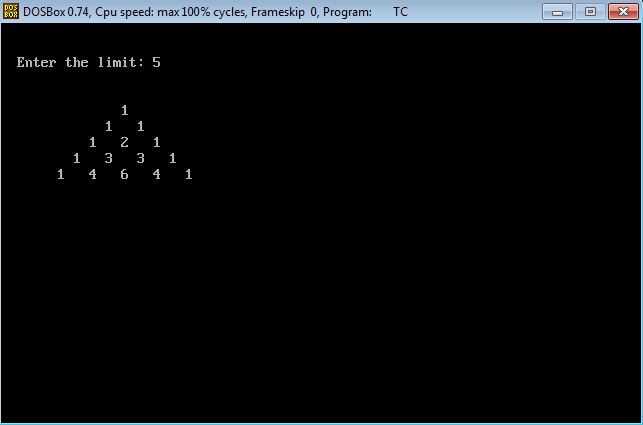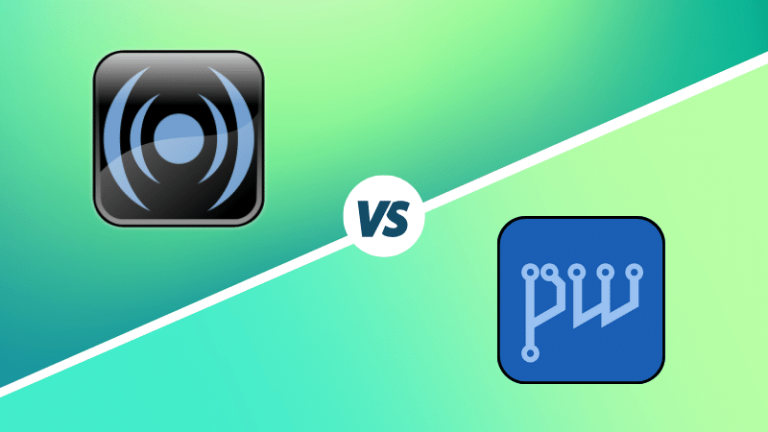Before going to the program for Pascal Triangle first let us understand what is a Pascal Triangle?
Pascal Triangle:
Pascal triangle is a triangular array of the binomial coefficients.
Program code for Pascal Triangle in C:
/* Program for Pascal triangle */ #include<stdio.h>
#include<conio.h> void main()
{ int i,j,k,n,c; clrscr(); printf("n Enter the limit: "); scanf("%d",&n); printf("n "); for(i=0;i<n;i++) { c=1; for(k=0;k<n-i;k++) { printf(" "); } for(j=0;j<=i;j++) { printf(" %d ",c); c=(c*(i-j)/(j+1)); } printf("n"); } getch();
}
Working:
- First the computer reads the value of the limit from the user.
- Then using the loop the value of c and the spaces required are printed.
- Finally we will be getting the pascal triangle.
Step by Step working of the above Program Code:
- Let us assume the value of limit as 4.
- It assigns n=4.
- It assigns i=0 and the for loop continues until the condition i<n is true
3.1. i<n (0<4) for loop condition is true
It assigns c=1.
Then it assigns k=0 and the for loop continues until the condition k<n-i is true
(k<4), So the for loop continues for 4 iterations and prints 4 blank spaces
Then it assigns j=0 and the for loop continues until the condition j<=i is true
j<=i (0<=1) for loop condition is true
It prints 1(value of c).
c=(c*(i-j)/(j+1)) (c=(1*(1-0)/0+1))) So, c=1
j++ So, j=1
j<=i (1<=0) for loop condition is false
So it comes out of the for loop.
i++ So, i=1
3.2. i<n (1<4) for loop condition is true
It assigns c=1.
Then it assigns k=0 and the for loop continues until the condition k<n-i is true
(k<3), So the for loop continues for 3 iterations and prints 3 blank spaces
Then it assigns j=0 and the for loop continues until the condition j<=i is true
j<=i (0<=1) for loop condition is true
It prints 1(value of c).
c=(c*(i-j)/(j+1)) (c=(1*(1-0)/0+1))) So, c=1
j++ So, j=1
j<=i (1<=1) for loop condition is true
It prints 1(value of c).
c=(c*(i-j)/(j+1)) (c=(1*(1-1)/1+1))) So, c=0
j++ So, j=2.
j<=i (2<=1) for loop condition is false
So it comes out of the for loop.
i++ So, i=2
3.3. i<n (2<4) for loop condition is true
It assigns c=1.
Then it assigns k=0 and the for loop continues until the condition k<n-i is true
(k<2), So the for loop continues for 2 iterations and prints 2 blank spaces
Then it assigns j=0 and the for loop continues until the condition j<=i is true
j<=i (0<=2) for loop condition is true
It prints 1(value of c).
c=(c*(i-j)/(j+1)) (c=(1*(2-0)/0+1))) So, c=2
j++ So, j=1
j<=i (1<=2) for loop condition is true
It prints 2(value of c).
c=(c*(i-j)/(j+1)) (c=(2*(2-1)/1+1))) So, c=1
j++ So, j=2
j<=i (2<=2) for loop condition is true
It prints 1(value of c).
c=(c*(i-j)/(j+1)) (c=(1*(2-2)/2+1))) So, c=0
j++ So, j=3
j<=i (3<=2) for loop condition is false
So it comes out of the for loop.
i++ So, i=3
3.4. i<n (3<4) for loop condition is true
It assigns c=1.
Then it assigns k=0 and the for loop continues until the condition k<n-i is true
(k<1), So the for loop continues for 1 iteration and prints 1 blank space
Then it assigns j=0 and the for loop continues until the condition j<=i is true
j<=i (0<=3) for loop condition is true
It prints 1(value of c).
c=(c*(i-j)/(j+1)) (c=(1*(3-0)/0+1))) So, c=3
j++ So, j=1
j<=i (1<=3) for loop condition is true
It prints 3(value of c).
c=(c*(i-j)/(j+1)) (c=(3*(3-1)/1+1))) So, c=3
j++ So, j=2
j<=i (2<=3) for loop condition is true
It prints 3(value of c).
c=(c*(i-j)/(j+1)) (c=(3*(3-2)/2+1))) So, c=1
j++ So, j=3
j<=i (3<=3) for loop condition is true
It prints 1(value of c).
c=(c*(i-j)/(j+1)) (c=(1*(3-3)/3+1))) So, c=0
j++ So, j=4
j<=i (4<=3) for loop condition is false
So it comes out of the for loop.
i++ So, i=4
3.5. i<n (4<4) for loop condition is false.
So it comes out of the for loop.
- Thus the program execution is completed.
Output:



![How to Log Out from Ubuntu Session [Beginner’s Tip]](https://linuxpunx.com.au/wp-content/uploads/2020/10/how-to-log-out-from-ubuntu-session-beginners-tip-768x412.jpg)



